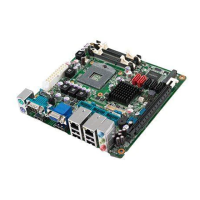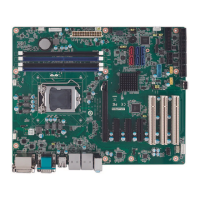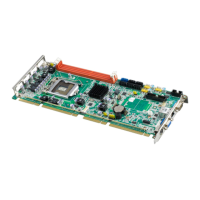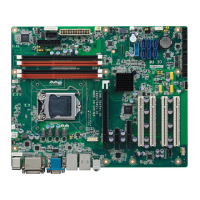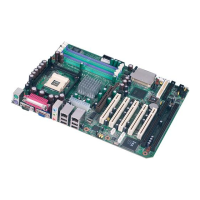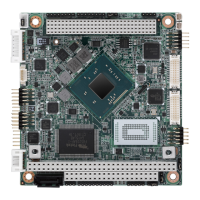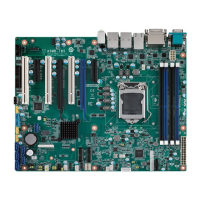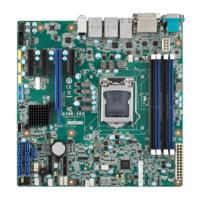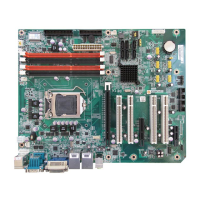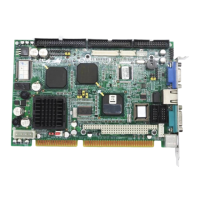Do you have a question about the Advantech MIO-5250 and is the answer not in the manual?
Overview of the MIO-5250 SBC, its form factor, and key features.
Detailed technical specifications including CPU, memory, I/O, and interfaces.
Details on CPU, memory, graphics, mechanical, electrical, and environmental specs.
Guide to identifying, setting, and describing the function of jumpers.
A table listing all jumpers and their functions.
Detailed configuration options for specific jumpers.
Explanation of jumper operation and schematic representations.
Overview of the system's various input/output connectors.
A comprehensive list of all connectors and their labels.
Information on physical layout, connector locations, and board dimensions.
Introduction to the AMIBIOS setup utility and its interface.
Instructions on how to access the BIOS setup menu.
Overview of the main BIOS setup screen and its components.
How to configure the system date and time settings.
Detailed explanation of various advanced BIOS configuration options.
Procedure for updating the system BIOS.
Configuration options related to Advanced Configuration and Power Interface.
Settings for Trusted Platform Module (TPM) security features.
Options for configuring CPU-related features and performance.
Settings for managing SATA storage devices.
Configuration for Intel Fast Flash Standby feature.
Options for managing USB port functionality and settings.
Settings for the embedded controller, including watchdog timer.
Configuration options for Super I/O devices like serial ports.
Settings for Always On Always Connected functionality.
Power Management features related to CPU states.
Settings related to the motherboard chipset and its components.
Configuration for the Host Bridge and Intel Integrated Graphics Device.
Settings related to the South Bridge controller.
Configuration options for system boot behavior and device priority.
Options for setting passwords and securing the system.
Options for saving changes, exiting BIOS, and resetting.
Saves current settings and exits the BIOS setup.
Exits BIOS setup without saving any changes.
Saves changes and restarts the system.
Discards changes and restarts the system.
Saves current settings without exiting BIOS.
Discards all current configuration changes.
Restores BIOS settings to factory default values.
Saves current settings as user-defined defaults.
Loads previously saved user-defined default settings.
Allows selection of boot device for a single boot.
Step-by-step instructions for installing the MIOe module and heatsink.
Detailed pinout information for the system's connectors.
Table of system I/O port addresses and their associated devices.
List of DMA channels and their current functional status.
Memory map of the first megabyte, detailing address ranges and devices.
Table mapping interrupt request lines to their interrupt sources.
Example assembly code for controlling the Embedded Controller watchdog timer.
Overview of the MIO-5250 SBC, its form factor, and key features.
Detailed technical specifications including CPU, memory, I/O, and interfaces.
Details on CPU, memory, graphics, mechanical, electrical, and environmental specs.
Guide to identifying, setting, and describing the function of jumpers.
A table listing all jumpers and their functions.
Detailed configuration options for specific jumpers.
Explanation of jumper operation and schematic representations.
Overview of the system's various input/output connectors.
A comprehensive list of all connectors and their labels.
Information on physical layout, connector locations, and board dimensions.
Introduction to the AMIBIOS setup utility and its interface.
Instructions on how to access the BIOS setup menu.
Overview of the main BIOS setup screen and its components.
How to configure the system date and time settings.
Detailed explanation of various advanced BIOS configuration options.
Procedure for updating the system BIOS.
Configuration options related to Advanced Configuration and Power Interface.
Settings for Trusted Platform Module (TPM) security features.
Options for configuring CPU-related features and performance.
Settings for managing SATA storage devices.
Configuration for Intel Fast Flash Standby feature.
Options for managing USB port functionality and settings.
Settings for the embedded controller, including watchdog timer.
Configuration options for Super I/O devices like serial ports.
Settings for Always On Always Connected functionality.
Power Management features related to CPU states.
Settings related to the motherboard chipset and its components.
Configuration for the Host Bridge and Intel Integrated Graphics Device.
Settings related to the South Bridge controller.
Configuration options for system boot behavior and device priority.
Options for setting passwords and securing the system.
Options for saving changes, exiting BIOS, and resetting.
Saves current settings and exits the BIOS setup.
Exits BIOS setup without saving any changes.
Saves changes and restarts the system.
Discards changes and restarts the system.
Saves current settings without exiting BIOS.
Discards all current configuration changes.
Restores BIOS settings to factory default values.
Saves current settings as user-defined defaults.
Loads previously saved user-defined default settings.
Allows selection of boot device for a single boot.
Step-by-step instructions for installing the MIOe module and heatsink.
Detailed pinout information for the system's connectors.
Table of system I/O port addresses and their associated devices.
List of DMA channels and their current functional status.
Memory map of the first megabyte, detailing address ranges and devices.
Table mapping interrupt request lines to their interrupt sources.
Example assembly code for controlling the Embedded Controller watchdog timer.
| Form Factor | Mini-ITX |
|---|---|
| Max Memory | 32GB |
| Expansion Slots | 1 x PCIe x16, 1 x Mini-PCIe |
| USB Ports | 4 x USB 3.0, 4 x USB 2.0 |
| Graphics | Intel HD Graphics |
| SATA | 2 x SATA III |
| CPU | Intel Core i7/i5/i3, Celeron |
| Chipset | Intel H110 |
| Memory | 2x DDR4 SO-DIMM slots |
| Storage Interface | SATA III |
| Ethernet | 2x Gigabit Ethernet |
| Audio | HD Audio |
| Display Output | HDMI, VGA |
| Serial Ports | 2 x RS-232/422/485 |
| Mini-PCIe | 1 x Mini PCIe |
| Operating Temperature | 0°C to 60°C |
| Power Supply | 12V DC |
| Digital I/O | 8-bit Digital I/O |
